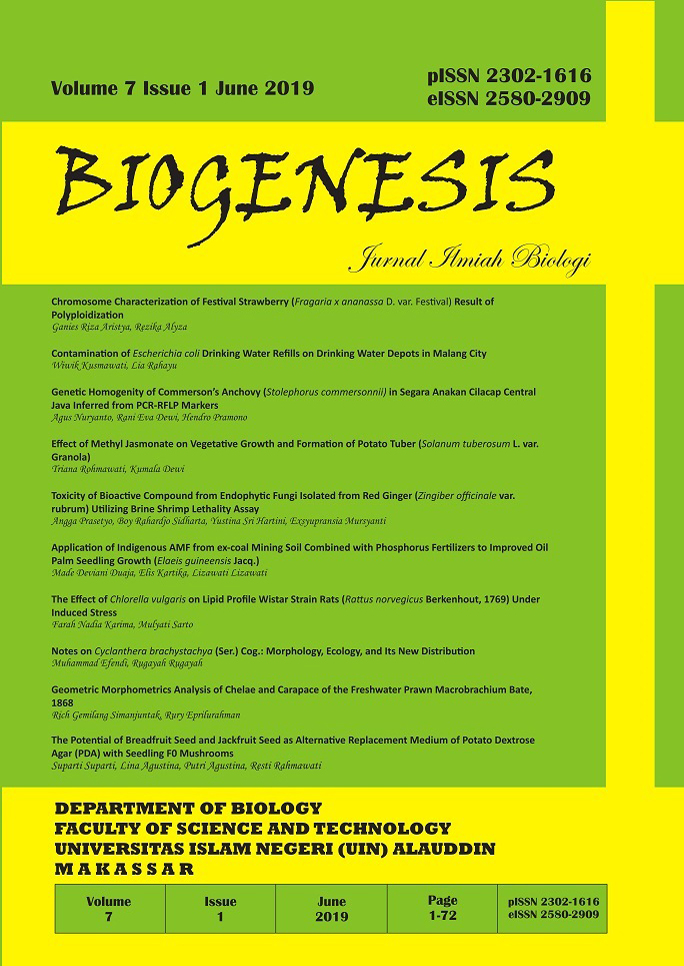Contamination of Escherichia coli Drinking Water Refills on Drinking Water Depots in Malang City
Abstract
Data from the Malang City Health Office shows the increasing number of refill drinking water depots in the city of Malang until 2013 there were 163 drinking water depots scattered in each Malang Subdistrict. The purpose of this study was to determine the contamination of Escherichia coli refill drinking water in drinking water depots in Malang. The samples taken were 20 refill drinking water depots in Malang. Sampling is done by simple random sampling. Escherichia coli examination using the Most Probable Number Test. Of the 20 samples tested, 2 samples met the requirements of drinking water quality according to PERMENKES and 18 other samples containing the number of coliform bacteria exceeding the maximum limit of 0 per 100 ml of water. There were Escherichia coli in 10 samples while 8 other samples contained other coliform bacteria.
References
Ashbolt NJ. 2004. Microbial contamination of drinking water and disease outcomes in developing regions. Toxicology. vol 198(1-3): 229-238. doi: https://doi:.org/10.1016/j.tox.2004.01.030.
Asfawi S. 2004. analisis faktor yang berhubungan dengan kualitas bakteriologis air minum isi ulang pada tingkat produsen di Kota Semarang. [Tesis]. Semarang: Universitas Diponegoro.
Dechesne M, Soyeux E. 2007. Assessment of source water pathogen contamination. Journal of Water and Health. vol 5 (S1): 39-50. doi https://doi.org/10.2166/wh.2007.133.
Dietrich AM. 2006. Aesthetic issues for drinking water. Journal of Water and Health. Vol 4(S1): 11-16. doi: https://doi.org/10.2166/wh.2006.0038
Dinas Kesehatan Provinsi Jawa Timur. 2013. Profil Kesehatan Provinsi Jawa Timur Tahun 2012. Surabaya: Dinkes Jawa Timur. hal 1-70.
Dinas Kesehatan Kota Malang. 2015. Profil Kesehatan Kota Malang Tahun 2014. Malang: Dinkes Kota Malang.
Edberg SC, Rice EW, Karlin RJ, Allden MJ. 2012. Escherichia coli: the best biological drinking water indicator for public health protection. Journal of Applied Microbiology. vol 88(S1): 106S-116S. doi: https://doi.org/10.1111/j.1365-2672.2000.tb05338.x.
Figueras MJ, Borrego JJ. 2010. New perspectives in monitoring drinking water microbial quality. International Journal of Environmental Research and Public Health. vol 7(12): 4179-4202. doi: https://doi.org/10.3390/ijerph7124179.
Fong SS, Burgard AP, Hering CD, Knight EM, Blattner FR, Maranas CD, Palsson BO. 2005. In silico design and adaptive evolution of Escherichia coli for production of lactic acid. Biotechnology and Bioengineering. vol 91(5): 643-648. doi: https://doi.org/10.1002/bit.20542.
Hijnen WAM, Beerendonk EF, Medema GJ. 2006. Inactivation credit of UV radiation for viruses, bacteria and protozoan (oo)cysts in water: A review. Water Research. vol 40(1): 3-22. doi: https://doi.org/10.1016/j.watres.2005.10.030.
Mukaromah AH and Yusrin. 2010. Pengaruh lama waktu simpan pada suhu ruang (27-29ºC) terhadap kadar zat organik pada air minum isi ulang. Prosiding Seminar Nasional Unimus. 12-13 Mei 2015. Semarang: LPPM Universitas Muhammadiyah Semarang. ISBN 978.979.704.883.9.
Prüss A, Kay D, Fewtrell L, Bartram J. 2002. Estimating the burden of disease from water, sanitation, and hygiene at a global level. Environmental Health Perspectives. waterborne 110(5): 537-542. doi: https://doi.org/10.1289/ehp.110-1240845.
Rahayu A. 2010. Deteksi adanya bakteri pada air minum dalam galon. Jurnal Ilmiah Kedokteran Wijaya Kusuma. vol 2(1): 1-6.
Ranjbar R, Ahmadnezhad B, Jonaidi N. 2014. The prevalance of beta lactamase producing Escherichia coli strains isolated from the urine samples in valiasr hospital. Biomedical & Pharmacology Journal. vol 7(2): 425-431. doi: http://dx.doi.org/10.13005/bpj/507.
Rosales-Colunga LM, Razo-Flores E, Rodríguez ADL. 2012. Fermentation of lactose and its constituent sugars by Escherichia coli WDHL: Impact on hydrogen production. Bioresource Technology. Vol 111: 180-144. https://doi.org/10.1016/j.biortech.2012.01.175
Rubaiah A. 2005. Pengaruh nilai produk yang dirasakan terhadap proses keputusan pembelian konsumen air minum isi ulang pada depot Aloa Bandung. [Tesis]. Bogor: Institut Pertanian Bogor.
Szewyk U, Szewzyk R, Manz W, Schleifer KH. 2000. Microbiological Safety of Drinking Water. Annual Review of Microbiology. vol 54: 81-127. doi: https://doi.org/10.1146/annurev.micro.54.1.81.
Wandrivel R, Suharti N, and Lestari Y. 2012. Kualitas air minum yang diproduksi di depot air minum isi ulang di kecamatan Bungus Padang berdasarkan persyaratan mikrobiologi. Jurnal Kesehatan Andalas. vol 1(3): 129-133.
Copyright (c) 2019 Wiwik Kusmawati, Lia Rahayu

This work is licensed under a Creative Commons Attribution 4.0 International License.
COPYRIGHT AND LICENSE STATEMENT
COPYRIGHT
Biogenesis: Jurnal Ilmiah Biologi is published under the terms of the Creative Commons Attribution license. Authors hold the copyright and retain publishing rights without restriction to their work. Users may read, download, copy, distribute, and print the work in any medium, provided the original work is properly cited.
LICENSE TO PUBLISH
1. License
The use of the article will be governed by the Creative Commons Attribution license as currently displayed on http://creativecommons.org/licenses/by/4.0.
2. Author’s Warranties
The author warrants that the article is original, written by stated author/s, has not been published before, contains no unlawful statements, does not infringe the rights of others, is subject to copyright that is vested exclusively in the author and free of any third party rights, and that any necessary written permissions to quote from other sources have been obtained by the author(s).
3. User Rights
Under the Creative Commons Attribution license, the users are free to download, reuse, reprint, modify, distribute and/or copy the content for any purpose, even commercially, as long as the original authors and source are cited. No permission is required from the authors or the publishers.
4. Co-Authorship
If the article was prepared jointly with other authors, the corresponding author warrants that he/she has been authorized by all co-authors, and agrees to inform his/her co-authors of the terms of this statement.
5. Miscellaneous
Biogenesis: Jurnal Ilmiah Biologi may conform the article to a style of punctuation, spelling, capitalization, and usage that it deems appropriate. The author acknowledges that the article may be published so that it will be publicly accessible and such access will be free of charge for the readers.


